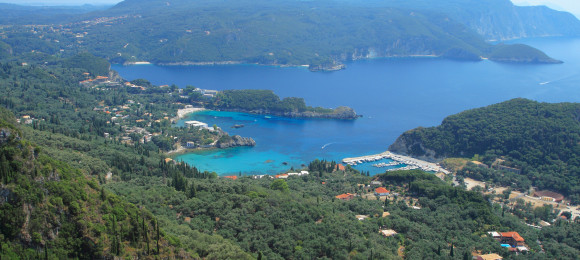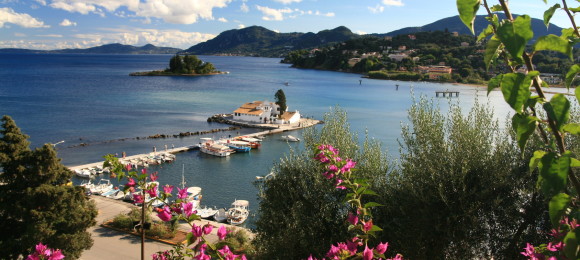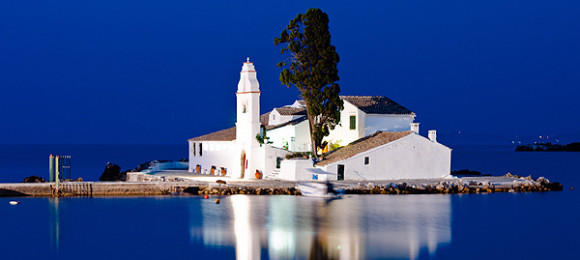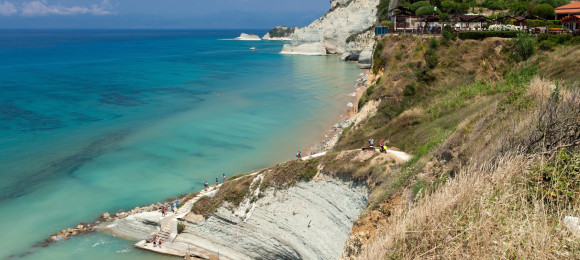Overview of Corfu
Blessed with a climate that favors its lush green landscape, Kerkyra is one of most popular Greek islands of the Ionian Sea, for many more reasons. Cypresses and olive trees, long beaches with crystal blue waters, cosmopolitan elegance and excellent tourist infrastructure, make up a highly attractive destination. Whilst its European influences, following the legacy of the Venetian, French and British occupation, Kerkyra has managed to maintain its Greek color and personality, having also evaded the ottoman invasion.
Its Old Town, a UNESCO World Heritage site, is a real jewel among similar sites of all Greek islands. Its remarkably mixed architecture that features narrow alleys (known as “kantounia”), small squares, churches, mansions and public buildings, reminds of Venice and Naples, with a French and English twist. Districts such as the old Campiello and Kofineta, in combination with the Corfu New Town, form an overall image which is purely distinctive, picturesque and romantic. As part of the Ionian islands, Kerkyra is also famous for having a long tradition in fine arts (remember the Ionian School of Painting). Therefore, apart from the museums and the Philharmonic Society of Corfu (founded in 1840), many interesting art events take place throughout the year.
Greece’s Ionian University, situated in the island, also contributes to its cultural and intellectual profile, along with a dash of youth energy. Corfu attracts a wide range of tourists, package tourism included, offering high quality options in accommodation, gastronomy and entertainment. Small fishing villages turned to developed touristic resorts contrast with areas untouched by modern times. The view of the island and the Ionian Sea from the imposing Mount Pantokrator (meaning “he who governs everything”) is actually a vivid reflection of Kerkyra itself: a dominating and breathtaking place to be.
Find more information on Corfu at the official website for Greek Tourism VisitGreece.gr
Beaches
Food
Things to see & do
: Sandy, not organized and the nudists’ favorite spot – comes along with the reputation of being “the loveliest beach in Corfu” 9.0 : Sandy and large beach, ideal for families and also a windsurfing centre. 8.0 : Pebbly beach with crystal waters, popular but still unharmed by tourism. The homonymous village used to be the home of British writer Lawrence Durrell (1912-1990), who was inspired by the island to write the account ”Prospero’s Cell”. 8.0 : Avoid a windy day and enjoy its strange rock formations, beautiful landscape and the well-known “Canal d’ Amour” – legend says that if couples in love swim here, they will stay together forever. 8.0 : The place to go in order to avoid tourist masses, relatively quiet, pebbly beach, with many facilities. 7.0
: Paleokastritsa, Greek cuisine 9.0 : Kerkyra Town, Mediterranean cuisine 9.0 : Kasiopi, Greek and Mediterranean cuisine. 9.0 : Pelekas, Greek cuisine 8.0 : Garitsa Bay, Greek and Mediterranean cuisine 8.0
: No wonder why it’s one of the most popular attractions in Corfu. It is an impressive landscape of superb beauty, consisting of two peninsulas and six small coves with cold waters, where tourist amenities succeed in respecting the natural scenery. Visit Paleokastritsa early in the morning, make a boat trip to nearby sea caves known as “blue grottoes” and enjoy the view from the Monastery of Panagia Paleokastritsas. 10.0 : Its mainly attractions include the Old and New Fort (gr. Paleo and Neo Frourio), the famous Liston (an arcaded street with parade of cafés, built as a copy of the Parisian Rue de Rivoli). Also, the Esplanade with the Platia Spianada (the largest square in the Balkans), the old British cricket pitch and the Saint Michael and George Palace (now hosting the Museum of Asian Art). You can also check out the statue of Ioannis Kapodistrias (native hero and the first president of Greece in 1827), the Solomos Museum (Dionysios Solomos is Greece’s national poet), the Byzantine Museum and of course the iconic 16th century church of Agios Spyridon, dedicated to the island’s patron saint. 10.0 : Easy accessed thanks to frequent boat itineraries. Valherna features a multi-photographed Corfu trademark: the monastery of Panagia Vlahernon. Pontikonissi, a small piece of land with pines, is, according to Greek mythology, Ulysses’ boat turned to stone by sea god Poseidon. 10.0 : 258 acres of land “revive” a slice of Corfu’s history through the neoclassical Mon Repos villa (a former royal palace and now the Museum of Paleopolis), two Doric temples and other relics of the past, thriving among the park’s lush vegetation. 10.0 : Visit nearby Ionian Islands of Paxi and Antipaxoi and also the Diapontia islands, only three of which are inhabited: Erikousa, Othonoi and Mathraki, all of them secret and serene retreats. 9.0 : Another top historic monument of the island that stands out as the former residence of Empress Sisi of Austria. 8.0 : Also, the Korision Lagoon, one of the few protected wetlands in Greece, home of 126 bird species. 8.0
Reviews of Corfu
No text reviews of Corfu exist. You can be the first one to review Corfu.


















